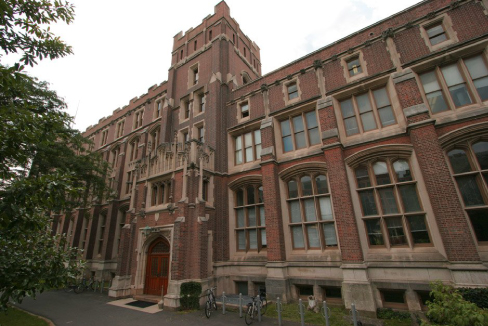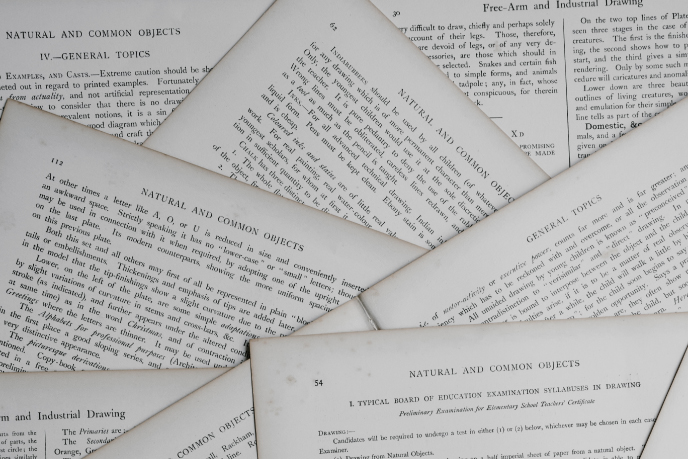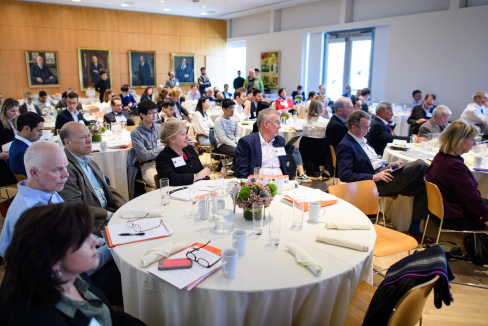“Wedges Reaffirmed”
In 2004, in a paper in Science, Stephen Pacala and Robert Socolow introduced “Stabilization Wedges,” a new way of quantifying the level of effort of carbon mitigation (a wedge of automobile efficiency, a wedge of CO2 capture and storage, etc.). In October 2011, Socolow released a new paper, “Wedges Reaffirmed,” on the websites of two non-governmental organizations, Climate Central and the Bulletin of the Atomic Scientist, which elaborates upon and updates the Science paper.
The Science paper proposed the following trajectory for the world’s CO2 emissions: emissions are held constant for 50 years, then decline in the following 50 years to achieve stabilization of the atmospheric concentration in 100 years (Figure 16). Since its publication, the global emissions rate has continued to grow, and it is now about 25% higher. Meanwhile, diplomats and environmentalists are advocating an even more ambitious trajectory. Socolow worries that the dissonance between aspiration and achievement will lead to a loss of resolve. He advocates “iterative risk management,” a flexible framework where goals are periodically reset so as to take into account both new science and newly revealed shortcomings of nominal solutions. Iterative risk management is also advocated in the 2011 report of the National Research Council, America’s Climate Choices, which Socolow co-authored.

“Wedges reaffirmed” proposes three messages to improve the communication of the climate change challenge to an electorate that Socolow assumes is more wary than hostile:
- Concede that, all in all, everyone would wish that our planet were larger so that our consumption patterns mattered less.
- Emphasize that climate science today is consistent with terrible outcomes, even though the likelihood of such outcomes is highly uncertain, so that action can be motivated by what we don’t know, not only by what we do know.
- Acknowledge that every mitigation action must be implemented attentively, lest it become a cure worse than the disease.
Compare these messages with the usual assertion that climate change is mostly about green jobs and innovation, that climate science is already definitive, and that government can be counted on to screen out dangerous policies.
Taking advantage of the flexibility of web publishing, ten comments accompanied the article. The comments – by Carter Bales, Ralph Cicerone, Freeman Dyson, Christopher Field, Robert Fri, David Hawkins, Rush Holt, Robert May, Phil Sharp, and Nicholas Stern – span a wide range of perspectives on climate change policy. The totality of the article and comments is a compelling introduction to the current discourse.
The Stabilization Wedges game
The Stabilization Wedges concept continues to be a popular teaching tool in the broader community, and 2011 took Roberta Hotinski, science communication consultant to CMI, to several events around the U.S. In June, Hotinski spoke and led the wedges game at this year’s Research Experience in Carbon Sequestration (RECS) in Birmingham, Alabama. In the fall, she facilitated a week-long wedges exercise as part of “Energy@Stanford and SLAC: Energy Research for the 21st Century,” an interdisciplinary summer course for over 100 Stanford graduate students from 19 departments.
In 2011 Hotinski worked with Capital Region Unitarian Universalists of New York (CRUUNY) Green Sanctuary members on a grassroots wedges game. With just a $1000 grant from The St. Lawrence District of the Unitarian Universalist Social Justice Council, the Sanctuary members organized a successful event in November at Rensselaer Polytechnic Institute in Troy, NY. The game was attended by U.S. Congressman Paul Tonko and Troy Mayor Elect Lou Rosamilia in addition to a broad spectrum of environmental stakeholders from the region, including church members, professors, students, lobbyists, and environmental professionals (Figure 17).
Hotinski also fields questions about the stabilization wedges concept from individuals and organizations on a weekly basis, particularly requests to reproduce the iconic wedge images in textbooks and other educational materials. In addition, online supporting materials for the wedges were viewed by over 2000 visitors to the CMI website.

Learning rates and a green energy deployment game
A new collaboration on renewable energy deployment has been developed between the Policy & Integration Group and Easwaran Somanathan, Professor, Indian Statistical Institute, New Delhi, and Reed Visiting Professor at PEI (2010-2011). International climate negotiations have made limited progress, but individual countries and regions have implemented various policies related to emission reduction, including promotion of renewable energy. The aim of this project is to study this phenomenon.
A game theoretic model was proposed to analyze the deployment of a green technology (Solar PV) by the U.S., the E.U., and China. Shoibal Chakravarty, associate research scholar at PEI, and Somanathan developed a model in which the decision makers have limited foresight and the rest of the world is always short-sighted. Green energy is three times more expensive than fossil energy initially, but costs go down with rising deployment. The three regions/countries may choose to be short-sighted (“myopic”), cooperate (form a “coalition”), or play a self-interested strategy (a “non-cooperative Nash game”). The model shows that cooperation and foresight bring down the costs of green energy to parity with fossil energy 4-8 years faster that the myopic case. One interesting result is that self-interested behavior with foresight (the Nash game) is a good second-best strategy to cooperation. The main result is that long-term policies can be very effective in accelerating the deployment of green energy.
The project website http://strategicdeployment.googlecode.com has the computer models and data used in this study.
Open source climate economics models
Another Policy & Integration Group project aims to bring energy-economics and climate economics-models into the open source domain. Open source versions of some Integrated Assessment Models like DICE and RICE have been developed. The group’s next goal is to develop energy-economics models for India. The models are written in Python, an open source programming language, using an open source modeling software (COOPR, https://software.sandia.gov/trac/coopr), and also other open access research software in the Operations Research community (COIN-OR http://www.coin-or.org/). The models can serve both as research and educational tools and the open access design can facilitate the contribution of other experts in this field. A dedicated website will be setup for the project shortly.



